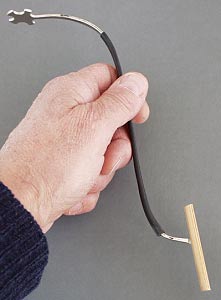How to fit.
Assuming you are refitting the existing sound post rather than making a new one, all you will need is a sound post setter, please don't try to use other tools! They only damage the F holes. I have seen many a sound post with tell tale bits of thread tied to them often accompanied by F hole damage, the result of an attempt to fit the soundpost with the wrong tools. A soundpost setter is a very simple tool see photo. I do appreciate that very few of you will have one to hand and therefore I will explain how to make a setter that will do the job admirably.
All you need to make the setter is a stiff wire coat hanger, a pair of pliers and a file. Cut a length of wire from the coat hanger about 10 inches long (25 cm.), and using the pliers bend it into the approximate shape of the setter example. The lower end, on which is impaled the sound post, needs to be filed to, if possible to a small blade profile, but if this presents a problem it will work with just a point. The blade (or point) is then pushed into the soundpost slightly above the mid point of its length and in the same direction as the grain of the soundpost. See sound post below.

